
Hey kids, we just had the great joy of a chat with a one of Asiaís most innovative filmmakers. Director Kim Jee-woonís singular style and creativity has made him a stand-out in his native Korea from his first film, The Quiet Family {1998} to the horror classic A Tale of Two Sisters {2003} and the previously unimaginable reimagining of Sergio Leoneís spaghetti westerns with The Good, the Bad, the Weird {2008}. Kimís latest opus, I Saw the Devil is a brilliantly savage tale of crime and revenge and he was kind enough to dissect it for us.
Dig it!
I Saw the Devil
Kim Jee-woon
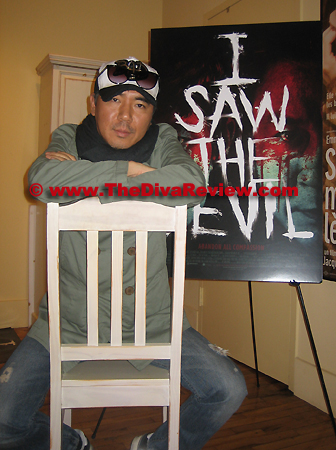 The
Lady Miz Diva: How did I Saw the Devil come to you?
The
Lady Miz Diva: How did I Saw the Devil come to you?
Kim Jee-woon: I had a US project that was lined up but was unfortunately delayed for a about year or so and I wanted something that I could do in between, so that meant I needed a script that was written by someone else. Fortunately, Mr. Choi Min-sik brought this script over to me saying it was very interesting; would I be interested in doing it? I took a look at it and it was a very raw, very powerful story, and what interested me as well was there were differences from other past revenge films and thatís what drew me. Choi Min-sik was in fact coming back from about four or five years of taking a break from film and he needed something that was pretty strong as well, perhaps thatís why he brought it over to me but I wanted to have a part in his comeback as well and thatís how I came to take it on.
LMD: Was it more difficult for you to work from someone elseís script for the first time?
KJ-w: Itís definitely a different feeling. Iím not sure I could say it was difficult, but itís a very different feeling from working with my own stuff. I kind of felt like a contract killer or a hitman called in to finish the job in a way. It gave me a different set of challenges and it was an interesting experience.
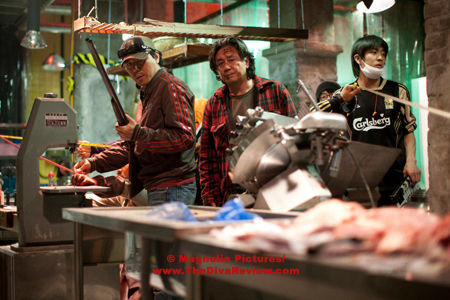 LMD:
The filmís graphic violence is very controversial. Was that part of the
original story?
LMD:
The filmís graphic violence is very controversial. Was that part of the
original story?
KJ-w: The violence that we seen onscreen was not especially different from the original script. In fact, much of it was already there. I might have adapted it a little bit more for the screen, but most of that violence was already in the script. If there was something I turned up from the original script, it was that there was a lot of this emotional dilemma and emotional lingerings that we turned up in the execution of the film and the inner struggle of the characters. The internal emotions that are driving these actions are what we were more concerned about turning up a little bit and making a bit more apparent. It wasnít so fleshed out in the script, but I decided to expand upon that and have it a little more apparent there.
LMD: Did you realise when you were making the film how controversial it would be? Did the filmís producers have any hesitation about the violence as you were filming?
KJ-w: Obviously the script was a very powerful one and there are always initial doubts about the visibility of something like this, but the fact that there were two very strong leads cast in the roles and a director they knew of assuaged those initial feelings. But when the film was finally produced and released, a lot of producers and investors felt that maybe this was even more than they ever expected it to be. I never really thought that it would go to the point where it was censored and stopped two times by the ratings board in Korea. For the first time in Korean film history to have a film stopped like that for the content. The reaction to the film was very divided; people loved it, people hated it, but even so there was much support in other sectors that really were able to identify with the film and connect with it. In that way, it was a good experience, but unfortunately it didnít do too well at the Korean domestic box office despite that.
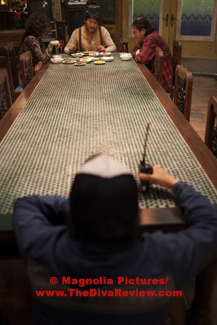 LMD:
Itís interesting because it seems like viewers in your home country
didnít really get it, yet the film is getting raves in the West.
LMD:
Itís interesting because it seems like viewers in your home country
didnít really get it, yet the film is getting raves in the West.
KJ-w: Interestingly enough, if I take an example, there was a study done on how Eastern people and Western people perceive a photograph. When Eastern people look at a photograph, they look at the central figure or central object with the background itís against. Western people on the other hand, seemed to focus more on just the figure itself, disregarding the background. Maybe this is an interesting comparison to how they see films, because in Korea when they see these films, they seem to connect all these external and side things about the film; like the societal background of the film. What the film is talking about in the greater context? My work as a director and all these other things, and they incorporate that into their view the film. Whereas with Western audiences, in my experience when theyíve seen this film, they look at just the text of the movie, of what the film is itself and what it contains without that extraneous information or external stuff. So it seems like thatís an interesting way of comparing how audiences see this film differently.
LMD: What was it like for you as a filmmaker to have faced censorship for the first time?
KJ-w: It was like eating sushi without wasabi. Like losing something that was essential to the taste. With the international version, thankfully Iíve been able to keep a lot of the wasabi in the film and let it have that full taste. So Iím glad that people will be able to experience the full flavor of the film.
LMD: Will we get a full sushi bar on the DVD?
KJ-w: We are definitely interested in making more supplemental materials for the DVDs, but the two lead actors are very busy people and my own current projects are slowly ratcheting up. Once I return to the Korea, thatís one of the first things Iíll have to be working on is more extras for the DVD.
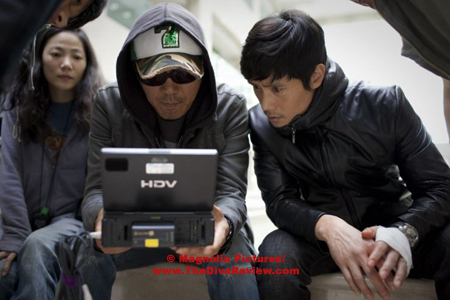 LMD:
Choi Min-sik worked on your first film and this is your third film with
Lee Byung-hun. Is there a comfort level working with these actors
multiple times?
LMD:
Choi Min-sik worked on your first film and this is your third film with
Lee Byung-hun. Is there a comfort level working with these actors
multiple times?
KJ-w: I worked with Choi Min-sik almost ten years ago on my first film, The Quiet Family; he was one of the family members. Lee Byung-hun Iíve worked with on my recent films. Because weíve worked recently and we have a relationship based on trust as actor and director, there are certain things that are advantageous in the film production. There is less time wasted in accommodating each other. Whatís interesting is to compare these two actors and their acting styles; if Lee Byung-hun is like drizzling rain, where it comes by silently and you find yourself wet in places, you donít feel the rain, but itís there. Thatís his kind of acting. And Choi Min-sik is kind of a very sudden storm that drenches you right away. Itís a flash and itís gone. So itís a very different kind of acting style and different methods they were working in that was interesting to compare.
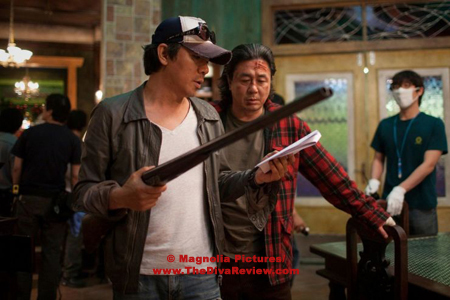 LMD:
What was it like to work with Choi Min-sik after he had such a long
break from acting?
LMD:
What was it like to work with Choi Min-sik after he had such a long
break from acting?
KJ-w: This could be taken in a humourous way, but I think after that long break he took, Choi Min-sik was kind of able to get everything out in his system that was sitting there. He literally says, ĎThe shit that he didnít take for a very long time,í he was able to get it out this time. I think as an actor he was able to feel the relief of that and for me as a director working with him, I was able to use that energy that he brought to this film in full force. He obviously wanted to have a strong comeback for his career and Iím happy to have been able to contribute and take part in that with this film.
LMD: Iíve heard I Saw the Devil described by different people as a crime film, or a horror movie, or an exploitation film. How would you describe it?
KJ-w: I think Iím in the process of looking for that myself. Interestingly enough, I think peopleís fear is what is at the center of a lot of genres of film. I could say that the fear of the unseen is what a horror film is. Fear of the future, of whatís to be could often be considered a science-fiction film. Fear of violence or desperate actions could be turned into a thriller. Fear of extreme situations might be turned into a noir film. Iím very interested in the genres of films that one can take and Iím always looking for new things to try in those areas. And as far as genres that I might be interested in that I havenít done yet, Iím definitely interested in a sci-fi kind of noir or a sci-fi thriller.
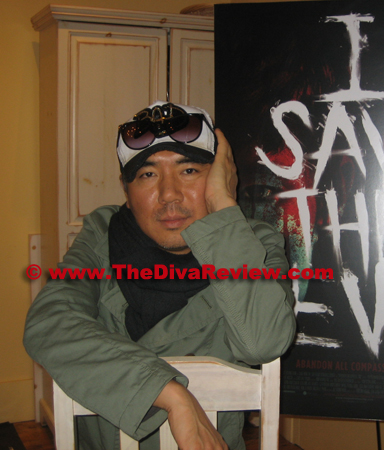 LMD:
Which leads to my question about what your next project is?
LMD:
Which leads to my question about what your next project is?
KJ-w: If everything goes as planned and there arenít any obstacles, the US film I was working on will go into production in August or September of this year.
LMD: And what genre is it?
KJ-w: If I Saw the Devil was a film about the remorse of someone who lost something that they couldnít protect, this film, The Last Stand is going to be an action film about someone who puts his life on the line to protect something and the bravery and courage that takes, in the process, almost going to the point of death to protect that.
~ The Lady Miz Diva
February 25th, 2011
Click here to read our Movie Review of I Saw the Devil
© 2006-2022 The Diva Review.com
|
|











